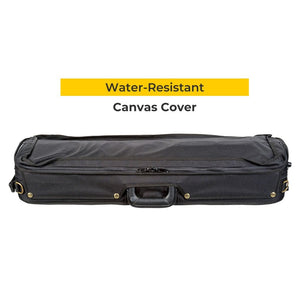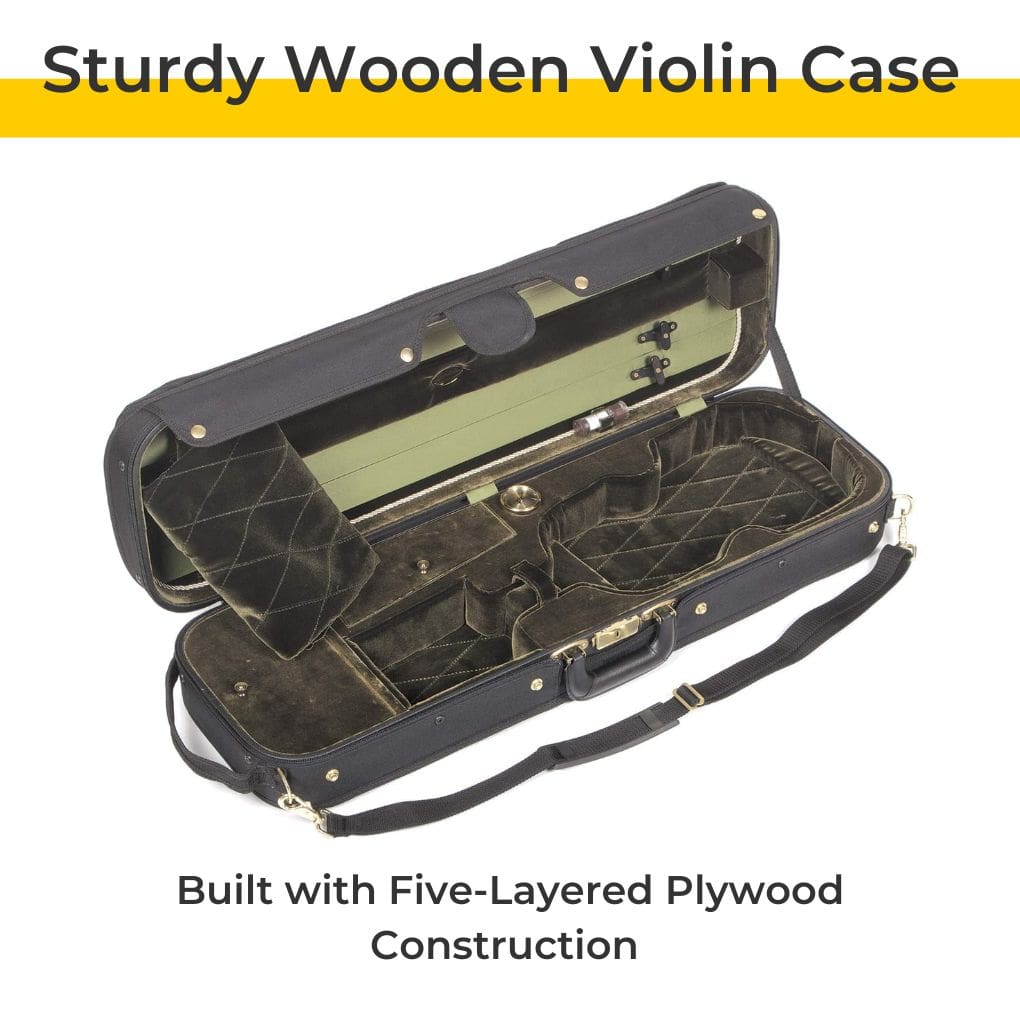Your Cart is Empty
Free Shipping on All Cases + 30 Day Return Guarantee
Free Shipping on All Cases + 30 Day Return Guarantee
Violin Cases
Cello Cases
Viola Cases
Other Cases
Bam vs Bobelock Violin Cases: Which Offers the Best Protection for You?
6 min read
Choosing the right violin case matters for protection, portability, and peace of mind.
Two brands usually come up in that conversation: Bam, known for its sleek, high-tech design, and Bobelock, appreciated for its classic look and reliable value. Both brands have strong reputations, but they serve different needs.
In this review, we’ll break down the key features, pros, and tradeoffs of each, so you can confidently pick the case that fits your playing style, budget, and priorities.
Key Takeaways
- Bobelock gives solid protection for $190-424 - Bam costs $200-1600 with top models being priced heavier for luxury.
- Bam weighs 3.5 lbs with high-tech foam - Bobelock is weighs around 5 lbs
- Bam's triple-ply beats temperature changes - Bobelock's plywood and fiberglass work for normal use.
- Bam looks sleek with modern features - Bobelock focuses on practical storage and classic reliability.
Which Case Fits Your Budget?
If budget drives your decision, Bobelock cases stand out first. These cases strike a solid balance between affordability and durability, making them a favorite among students and working musicians alike.
Entry-level models like the Bobelock 1007 start around $190, while premium options like the Corregidor violin case top out near $424. That puts Bobelock squarely in the mid-range category, providing practicality without being bare bones.

Bam, on the other hand, plays in a different price league. While their lineup starts at around $200, high-end cases like the Orchestra Supreme violin case can push north of $1,600. You get high-end features, modern design, and professional-grade protection, but it comes at a cost.

The takeaway is simple. Bobelock gives you dependable protection at a very reasonable price. If you’re after something stylish and sturdy that is bidget friendly, Bobelock delivers. But if you're ready to invest in top-tier materials and sleek design, then Bam might be worth the extra cash.
Which Case Is Light Enough for Daily Use?
If you're carrying your violin every day or constantly traveling for rehearsals and performances, weight matters a lot. The various Bam violin cases really shine here, as their innovative construction allows for impressive protection without the usual bulk that comes with traditional wooden cases.
For context, the average violin case weighs between 6 to 7 pounds. Most of those are standard oblong cases made from wood. By comparison, Bam violin cases often come in well under that range. For example, the Bam Hightech Contoured Violin Case, priced around $793, weighs just 3.5 pounds. That’s less than half the weight of many traditional options.

While they might cost more upfront, Bam cases can go the distance. They’re built to last decades without weighing you down, and that means less strain on your back, shoulders, and joints over time.
In comparison, one of Bobelock’s lightest fiberglass cases, the Bobelock 1063 Violin Case, weighs about 5 pounds and is priced at $240.

While it isn’t lighter than the BAM model, it still offers good impact resistance and a stylish look for much less.
What Materials Offer the Best Protection?
Bam and Bobelock take different approaches when it comes to materials. Here’s what each one uses:
Bam's Material Advantage
Bam violin cases are known for using high-tech materials that combine strength, light weight, and serious protection. Here’s a breakdown of the materials they use, along with some standout models.
Triple-Ply Hightech Construction (ABS, Airex Foam, ABS)
Bam’s signature material mix includes two layers of ABS wrapped around a core of Airex foam. The result? A tough, thermal-resistant shell that’s still light enough to carry comfortably.
Take the Panther Hightech Contoured Violin Case. Often referred to as the “gangster” violin case for musicians, it uses this triple-ply construction to protect instruments from impact and temperature changes.
The rubber exterior is more scratch-resistant than glossy finishes and less likely to slip from your grip.

Polycarbonate
Polycarbonate adds another level of toughness. It’s the same material used in bulletproof glass. That tells you all you need to know about its strength and shock resistance. It also holds up well against heat and scratches.
The Bam Supreme L'Opera Hightech Contoured Violin Case, for instance, uses a blend of polycarbonate, Airex foam, and ABS to create an extremely protective shell that keeps your instrument safe from impact, temperature changes, and daily wear. Bam even upgraded the locks on this one to second-generation polycarbonate.

What Bobelock’s Made Of
Bobelock violin cases take a more traditional route when it comes to materials, but they still deliver great durability and smart features at a much more accessible price point.
Plywood
Plywood remains one of Bobelock’s go-to materials. It offers excellent structural integrity, great shock resistance, and a solid track record of reliability. The multi-layered construction adds strength while keeping the case sturdy without being overly heavy.
Check out the Bobelock 1017 Violin Case.

Built from five layers of plywood, it includes thoughtful touches like a velvet suspension interior, a hygrometer, and an instrument blanket.
Fiberglass
Bobelock’s fiberglass models are made for musicians who want something tougher and more modern. The fiberglass shell offers an excellent strength-to-weight ratio and handles impact, heat, and moisture well. It’s also more weather-resistant than plywood.
The Bobelock 1027 Fiberglass Arrow-Shaped Violin Case, priced around $218, has a sleek, slim profile that still offers solid protection. It features a free travel case, a velour interior, room for your shoulder rest, a bigger internal pocket, and adjustable shoulder straps.

These fiberglass violin cases are ideal if you're traveling often or just want something lighter that still holds up.
Which One Wins on Design and Features?
Bam cases have a sleek, modern vibe that instantly stands out. They’re available in bold colors like azure blue, orange, navy, and white, giving players a stylish edge whether on stage or in transit. But they’re not just about looks.
They also include smart design features like airtight seals, comfy neoprene backpack straps, padded shoulder straps, and removable accessory pouches that make life easier on the go.
A good example is the Bam La Défense Slim Violin Case. This model blends form and function like few others. It has a distinctive half-moon shape that’s ultra-slim, compact, and stylish, especially with finishes like brushed aluminum or bright orange.

But what really makes this case stand out is what’s under the hood.
Here’s what you get:
-
Air-Tight Seal: Keeps moisture and dust out, ideal for humid climates or travel.
-
Backpack Straps: Neoprene straps let you carry it like a backpack or over your shoulder.
-
Bonus Perks: Removable accessory pouch, two bow holders, combo locks, and foam padding that cradles your violin like a hammock.

Bobelock cases, on the other hand, focus on classic design and practicality. You’ll find velvet-lined interiors, spacious storage compartments, and features like rain flaps, string tubes, and built-in hygrometers across most models.
These are workhorse, quality cases made for everyday use, especially for students, educators, or budget-conscious professionals.
One standout is the Bobelock Corregidor Professional Oblong Violin Case.

It includes:
-
Velvet Interiors: Plush, French-fitted lining in colors like wine or silver protects your violin from scratches.
-
Built-In Hygrometer: Helps maintain more consistent humidity levels to prevent wood damage—a lifesaver in dry or wet climates.
-
Spacious Storage: Two compartments fit shoulder rests, sheet music, and rosin without clutter.
-
Durable Exterior: Water-resistant nylon and reinforced corners handle daily bumps and weather.

This case takes traditional design to a premium level while still offering great functionality.
Which Case Handles Temperature Changes Better?
Both Bam and Bobelock violin cases work hard to protect your instrument from environmental changes, but they go about it in different ways.
Bam’s Hightech Foam Core does an impressive job of slowing heat penetration, keeping the inside stable even if you leave the case in a freezing car or under blazing sun. This means fewer worries about cracks, glue failures, or warped wood during outdoor gigs or cross-country flights. Read our review of Bam violin cases.

On the other hand, Bobelock cases rely on more traditional materials. While they’re still solid choices for protection, they don’t have the high-tech insulation of Bam violin cases.
Plywood models offer moderate resistance to temperature changes because wood naturally provides some insulation. However, these cases are more vulnerable to gradual temperature fluctuations over time compared to Bam’s advanced foam core.

Fiberglass models fight moisture well but won’t stop heat from creeping in during a summer festival or winter commute. If a fiberglass case is exposed to extreme temperatures for too long it could impact the instrument inside.
The takeaway? Bobelock suits most players, especially those who play indoors or require dependable, affordable cases. Bam is better suited for professionals, frequent travelers, or those in extreme climates who need enhanced protection.
Bam vs Bobelock Violin Cases: The Verdict
Both Bam and Bobelock violin cases protect your instrument, just with different priorities. Bobelock delivers sturdy, budget-friendly protection that's perfect for students and casual players.
Bam costs more, but it buys peace of mind, especially for pros and frequent travelers. Its lighter weight, better temperature control, and smart features make it the go-to for top-tier protection.
In the end, Bam’s higher price is really an investment in your instrument’s long-term safety.
Ready to choose? Browse our Bobelock violin cases or explore our best-selling Bam violin cases to find your fit.
Leave a comment
Want the Best Deals?
Best deals & promos, back-in-stock updates, newest cases, best sellers & more, sent straight to your inbox when you sign up.

